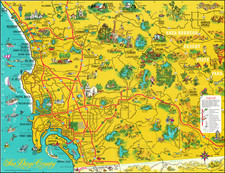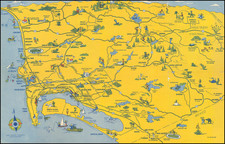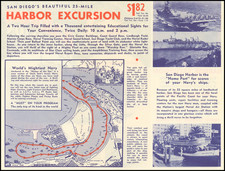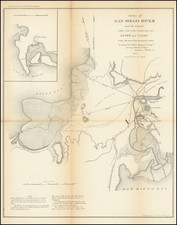San Diego's First Commuter Railway, to the Border with Mexico!
Impressive set of three early San Diego manuscript maps, showing the nascent National City & Otay Railway along with its Tia Juana, Oneonta, and La Presa branches.
Drawn in 1888 by R. H. Stretch, the map tracks the railroad's operations from the international border up to National City. Notably, three of the neighborhoods that the railroad terminates at or passes through no longer exist: Tia Juana, Oneonta, and Otay City have now all disappeared or been incorporated into other cities. Both Otay City and Oneonta would mostly be destroyed in the 1916 floods caused by the collapse of the Sweetwater Dam.
The archive of three maps was produced at a pivotal time early in the railroad's history. The first passengers on the line between National City and Otay City were carried on June 15th, 1887, and by October of that year, the branches to Tia Juana and Oneonta were announced. These branches, extending out to present-day San Ysidro and Imperial Beach, were supplemented by one further line that branched up the Sweetwater River to La Presa.
The first of the maps shows the southernmost connections, from Otay City to Tia Juana and Oneonta. The second sheet shows the section in the La Nacion Rancho, passing through Chula Vista and National City. In Chula Vista, the railway follows Third Avenue while in National City it is closer to the water. The third and final sheet shows the branch to La Presa.
The railroad was financially backed by a number of San Diego sources. Among them were the Kimball brothers, who had been involved in nearly every early San Diego railway venture since the late 1860s. These San Diego and National City developers had long pushed for greater interurban connections in the region, and the easy connections between areas where they owned large amounts of land benefitted them greatly. The first train left from Wallace Kimball's house, and the National Record describes the brothers on the first passenger trip as "as happy as a bunch of children with firecrackers on the Fourth of July." Colonel William Dickinson, who managed the real estate arm of the California Southern Railway at the time, was another key proponent of the railway.
The maps were executed by R. H. Stretch, of him we find little record. We find him moving about California in the 1880s, and one of the few connections that trace him to San Diego is his mention in the incorporation of the 1885 San Diego Flume Company, an early irrigation company.












![Southeastern Portion of California [San Diego, San Bernardino and Inyo Counties]](https://storage.googleapis.com/raremaps/img/small/83750.jpg)



![Map of the City of San Diego and Vicinity [cover title:] Street Map of San Diego](https://storage.googleapis.com/raremaps/img/small/77116.jpg)